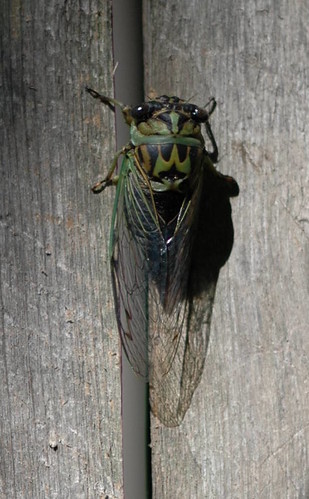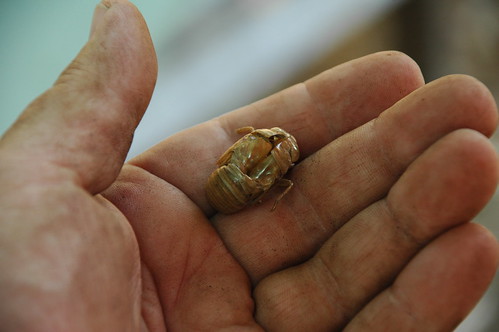Although I’ve lived in Brooklyn since 1992, I didn’t encounter Sphecius speciosus, the Eastern Cicada Killer, until we moved to Flatbush in 2005. It was summer, and I was working outside in the garden. Suddenly, here was the biggest wasp I had ever seen, large and loud, buzzing around my driveway and digging into the lawn next to it. I freaked out. I hosed out the burrow and destroyed the nest.
I regret having done that. I attribute my over-reaction partially to the stresses of being a first-time homeowner. I now find them beautiful. I consider myself lucky that we live in an urban area where these specialists can thrive. Besides, they are much too busy during their short adult lives to bother with people.
Sphecius speciosus, Eastern Cicada Killer, with prey, just inside the Eastern Parkway entrance of the Osborne Garden at Brooklyn Botanic Garden, August 2009
They have a fascinating, if gruesome by human standards, life history. It could easily be the inspiration for the xenomorph of the Alien movie series.
After mating, the female digs out a deep tunnel leading to a multi-chambered nest. They’re impressive excavators. This debris pile appeared overnight alongside our driveway and sidewalk in August of 2012. The concrete curb is 3″ high.
Here’s the entrance to a nest in Cattus Island Park in Toms River, in the coastal pine barrens of New Jersey, in August of 2011. Note there are 4 different colors of sand, showing the different layers, and depths, the female reached.
The female then hunts for and captures an adult cicada, paralyzing it with its sting without killing it. It returns with the cicada to its burrow, dragging it into one of the chambers of the nest. It lays a single egg on the cicada. It repeats this process several times. The female dies soon after egg-laying.
Sphecius speciosus, Eastern Cicada Killer, with prey, at the Flatbush CommUNITY Garden, July 2008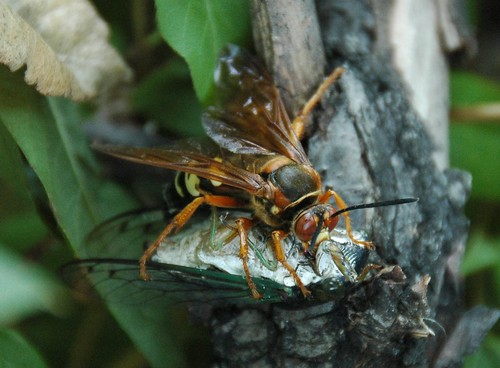
When the egg hatches, the larva feeds on the still-living cicada. When the cicada hs been completely consumed, the larva spins a cocoon and overwinters as a pre-pupa. In Spring it emerges from the cocoon as a pupa, eventually metamorphosizing and emerging as adults, male and female, for mating and renewing the cycle.
Dog-day Cicada (annual Cicada) in Prospect Park, July 2008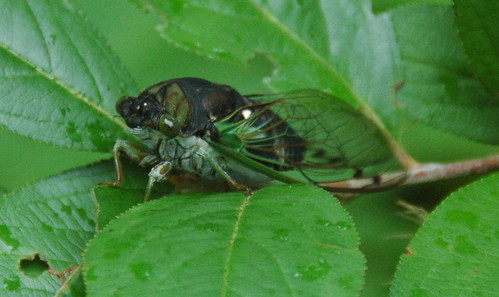
Cicada killers are solitary wasps. Males emerge from pupal cases in mid-July to early August, a few weeks before the females. The males tunnel out of the ground, leaving telltale holes, and select a territory that they actively defend. Females mate soon after emerging, and then begin digging burrows in the ground using their mandibles and legs. The burrows can be several feet deep with numerous branches.
Once construction is complete, the female searches in trees and shrubs. Upon capturing a cicada, the female stings it injecting venom. Then, she carries the cicada back to the burrow, where she lays an egg on its living, but paralyzed body. Within two weeks, the egg hatches into a larva, eats the cicada, and develops into a pre-pupa, the stage at which it will spend the winter. Cicada killers are active in late summer, the same time that cicadas are present. By September, most adults have died.
Although visually alarming, these wasps pose little threat. Females are not aggressive and rarely sting, unless excessively provoked. Males often display territorial behavior and will dive-bomb people’s heads; however, they have no sting and pose no real threat.
– Cicada Killer, Master Beekeeper Program, Cornell University
Felis catus ssp. cicadakilleratus ‘Ripley’ on my back porch, August 2009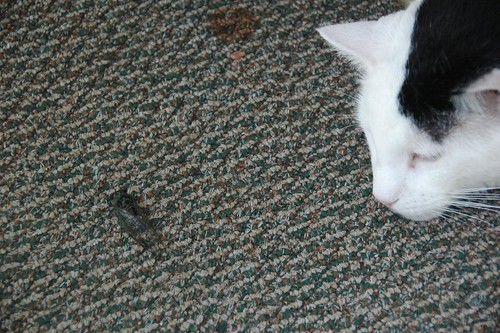
I was prompted to write this in response to a message sent out on the Flatbush Family Network:
We seem to have an underground yellow jacket nest on our front walkway with a “Queen” that is about 2.5 inches long…..a little frightening to me but will absolutely scare the wits out of my kids- she looks like she can carry her own luggage! Anyone know an exterminator that can come and get rid of this Quick!?
Thanks, Lori
[bit.ly]
Related Content
Dog-Day Cicadas, 2008-07-11
Flickr photo set
Links
University of Kentucky Entomology
Ohio State University Extension


